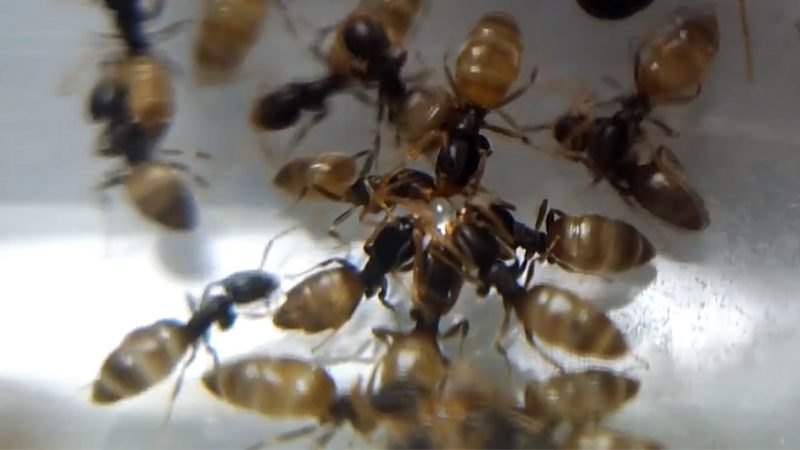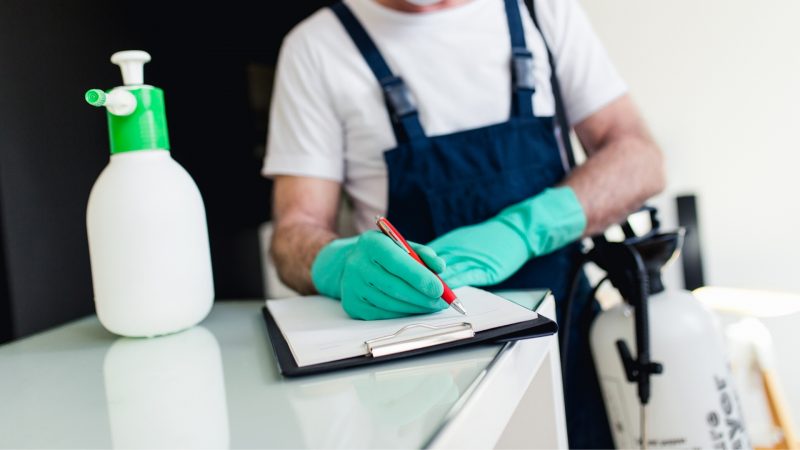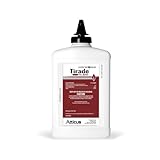Ghost ants are a common household pest found near food sources, firewood, logs, or crevices in and around your home. These ants are small and can easily be mistaken for odorous house ants. A ghost ant infestation can quickly become a significant problem if not dealt with properly.
A proven effective method for getting rid of ghost ants is using ant baits specifically designed for this species. Avoid using insecticide sprays, which may cause ghost ants to panic and disperse into multiple spots.
To help identify ghost ants, we have included information on their appearance and behavior and methods to control their infestation, including recommended products. Additionally, we have provided some effective home remedies to help control and eradicate ghost ant infestations. Let’s explore these methods in further detail below.
What Are Ghost Ants?
Ghost ants (Tapinoma melanocephalum) are tiny, pale ants that are difficult to see and can easily be mistaken for odorous house ants. When crushed, they emit a scent similar to that of rotten coconut.
These ants are attracted to sweet foods, honeydew, and moist areas and can build their nests indoors and outdoors. Ghost ants have similar biology to Pharaoh ants and are common indoor invaders in tropical regions of the United States, such as south and central Florida and Hawaii.
They are believed to have originated in Asia or Africa, although this has not yet been confirmed. Ghost ants can also be found in Canada, Puerto Rico, Texas, and various Caribbean Islands. Due to their small size and pale appearance, they can easily be transported into homes through goods or crates without being noticed.
What Do Ghost Ants Look Like?

Ghost ants have a distinct appearance, including dark brown heads, thoraxes, pale yellowish legs, and abdomens. They have six legs and are approximately 1.3 to 1.5 mm in length.
Worker ghost ants are monomorphic, meaning they are all the same size and shape. A single ghost ant colony can contain multiple queens, and they can extend their colonies to subcolonies.
The colonies are composed of fertile female queens and males, as well as thousands of workers that support the colony and care for the baby ghost ants (pupae and larvae). After the colony is established, queens develop new colonies through budding, where a new colony is created as a separate entity from the original colony.
Where Do Ghost Ants Live?
Ghost ants can build their nests in various warm and moist locations, indoors and outdoors. Outdoor colonies can be found in the ground, inside crevices, holes, firewood, logs, under stones, piles, leaves, sidewalks, and wall voids.
In houses, ghost ants can be found in walls, behind cabinets, plant pots, bathrooms, kitchens, and under carpets, among other places. They can be easily seen in electrical outlets, under switchboards, and behind baseboards. Ghost ants are sometimes referred to as tramp ants because they can relocate and establish new colonies in different locations.
Are Ghost Ants Dangerous?
They can be considered dangerous because they can carry viral and bacterial diseases into your house from trash bins or dead organisms. The presence of spilled juice or unhygienic conditions in your home can attract ghost ants. A larger infestation of ghost ants can cause havoc and become a nuisance.
They have the ability to multiply rapidly and establish separate and independent colonies wherever they find favorable conditions. Ghost ants can spoil your food products and pose a potential threat to your health. It is important to take preventive measures to control the larger infestation of ghost ants in your home.
What Attracts Ghost Ants?
Ghost ants are attracted to your house for food sources, moisture, and shelter. They prefer sugar-based foods such as sugar, candy, juices, cakes, jams, etc. The ghost ants also prey upon aphids and mealybugs, and other plant-eating insects for honeydew.
If you have houseplants that attract aphids, there is a high chance of ghost ants infestation. The improperly stored food and moisture on leaky pipes sinks, or potted plants can also attract ghost ants into your house or yard.
Related: What Attracts Ants? Information and Facts
Do Ghost Ants Bite?
Ghost ants do not have a stinger but can bite if threatened. However, their bite is not dangerous and shows no evident reactions on your body. They do not show aggressive behavior but have the potential to spoil your food items and carry diseases into your house.
Related: Ant Bites: Identification, Treatment, Allergic Reactions & More
Ghost Ants in Specific Places

Ghost ants are attracted to homes and cars for a variety of reasons, including food, shelter, water, and favorable temperatures. At first, they may go unnoticed due to their yellowish-pale appearance. These ants commonly make nests in the kitchen, bathroom, yard, pantry, and even in cars.
Kitchen
In the kitchen, ghost ants can be found under sinks, behind cabinets, in crevices, or in other dark and moist areas. They are attracted to unhygienic situations, improperly stored food, spilled juices, and dripping pipes. Using ant baits designed for indoor use can help get rid of them.
Bathroom
In bathrooms, ghost ants may be found under sinks, near pipelines, in wall voids, under bathtubs, or near showers. They are drawn to the warmth and availability of water, so it’s important to keep bathrooms clean and dry to prevent infestations.
Ghost Ants in Pantry
In pantries and cupboards, ghost ants are mainly drawn to easily accessible food items. To prevent infestations, insect-repellent plants or spices can be used, and insecticide dust can be placed at nesting sites to get rid of colonies. Ghost ant bait can also be used to draw them out and kill the entire colony. Keeping the area clean and free of spilled food is also important to prevent food contamination.
Ghost Ants in Car
In cars, ghost ants are attracted to unhygienic conditions and trash. To prevent infestations, all food items should be removed from the car, including candy wrappers and juice boxes. A vacuum cleaner can be used to remove ghost ant colonies, and foggers may also be applied if necessary.
Home Remedy for Ghost Ants | Get Rid of Ghost Ants Naturally
Besides chemical methods, you can also use home remedies to get rid of ghost ants naturally. In the following sections, we have shared various home remedies that you can use to eradicate ghost ant colonies.
Soap water is a commonly used and effective home remedy that is inexpensive and shows instant results. Simply mix equal parts liquid soap and water in a spray bottle and apply it to the nesting sites and entry points of ghost ants to suffocate them.
White vinegar and apple cider vinegar can also be used as an insecticide to eradicate ghost ant infestations. Mix white vinegar and water in a 2:1 ratio, apply it to the entry points, and completely drench the nesting sites of ghost ants to kill most of them.
Brine: Prepare salt and water solution to eradicate the ghost ants. Spray the solution on the nesting site of ghost ants and leave it overnight for the best results.
Natural Ghost Ant Baits | DIY
If you prefer to use natural ghost ant baits, several DIY options are available. Ghost ants are attracted to liquid-based food products, so a liquid bait can be prepared by mixing sugar or jam with 2 tablespoons of boric acid and placing it near the ants’ entry points. Alternatively, a grease-based bait can be prepared using peanut butter and 2 tablespoons of boric acid, then placed near the nesting site of ghost ants.
Using these home remedies in conjunction with chemical methods can eradicate ghost ant infestations and prevent future infestations.
Related: Best Natural Ant Sprays | Kids and Pet-Friendly Sprays
Insect Repellent Plants
You can also use insect-repellent plants to prevent and control the ghost ants infestation in your house or lawn. Some of the best ghost ant-repellent plants are mint leaves, cucumber, turmeric powder, garlic, black pepper, cucumber slices or peels, etc.
Diatomaceous Earth Powder
The diatomaceous earth powder is an organic, non-toxic, and eco-friendly way to kill ghost ants. Evenly sprinkle the powder near the entry points and on the nesting sites of ghost ants. The powder will damage the exoskeleton of ghost ants and will ultimately cause their death.
How to Get Rid of Ghost Ants in the House: Ghost Ant Control

Ghost ants can be drawn into homes due to unhygienic conditions or the presence of a favorable environment for nesting. After a single colony infestation, ghost ants begin to multiply and build separate colonies both indoors (in holes, crevices, cabinets, under sinks, etc.) and outdoors (in potted plants, under loose logs, piles, stones, etc.). It is important to take measures to get rid of ghost ant infestations before they lead to major issues.
The eradication of ghost ants is considered difficult because their nests are not easy to locate, and these ants can go unnoticed during the earlier stages of infestation. Several methods can be used to get rid of indoor and outdoor ghost ant colonies depending on the level of infestation.
The first step in eliminating ghost ant colonies is identifying the problem. Before taking strict measures or applying a method to get rid of the pest problem, it is necessary to locate the area of infestation. Once the area is identified, the best method for getting rid of ghost ants can be chosen. One effective method is the use of ant baits, and in the following sections, we will discuss how they work against ghost ants.
Ant Baits for Ghost Ants
The use of ant baits is considered the most reliable and effective method to eradicate ghost ants. Using gel and liquid-based baits is recommended because ghost ant workers prefer liquid-based food products.
To locate the outdoor trails and shelters of ghost ants, try looking near firewood, under stones, potted plants, loose bark, mulch, and organic matter. To find the nesting sites and trails in your house, look near holes, wall voids, moisture sources (such as under sinks, leaky pipes, showers, etc.), behind kitchen cabinets, and electrical appliances.
After locating the trails and nesting areas, apply gel or liquid baits to the entry points of ghost ants. Several ghost ant baits are available commercially, and the best one can be selected according to the place of infestation. Read the instruction manual on the bait and monitor it daily for the best results. You may need to replace the bait if there is a larger ghost ant infestation in your house or outside.
Indoor baiting typically shows results in a short amount of time, whereas outdoor baiting may take longer due to multiple unknown nesting sites. However, liquid baits give the best outcomes compared to other pest control methods.
- ATTRACTS & KILLS: TERRO liquid ant baits indoor effectively...
- KILLS THE ANTS YOU DON'T SEE: TERRO ant bait is designed to share...
- FAST-ACTING: Noticeable ant activity reduction within days as...
- READY TO USE: Simply place ant baits indoors with no setup...
- VERSATILE HOME PLACEMENT: TERRO ant traps are ideal for use along...
- One 8 count package of Raid Ant Killer Baits protects against...
- Raid Ant Killer works for up to 3 months to help control ants in...
- This pest killer comes in convenient Raid Ant Traps where ants...
- Raid Ant Killer is ideal for use throughout your home, including...
- Try other Raid bug spray and insect killer products for all of...
Insecticide Sprays
Insecticide sprays are also used to kill ghost ants, but they are not as effective as ant baits. This is because spray only kills worker ants and not the entire colony. If the queen is not killed, then nothing has been achieved. Therefore, multiple and frequent insecticide treatments are necessary to kill ghost ants if you opt for ant killer sprays.
Insecticide sprays are easily available commercially, and it is important to follow the guidelines given on the spray for efficient results. You can also combine the ant bait method with insecticide spray for effective outcomes in a short period.
For outdoor ghost ant eradication, liquid insecticides can also be used. Locate the ghost ant mounds and drench them with 1 to 2 gallons of liquid insecticide according to the instruction manual provided with the product. It is important to remember that insecticide sprays and liquid insecticides are not the most effective method for ghost ant eradication, and ant baits should be the primary method used.
- Raid Ant & Roach kills a wide variety of insects including...
- Crawling insect killer with residual insecticide power for up to...
- Also kills palmetto bugs, silverfish, crickets, earwigs,...
- Ant & Roach spray with no lingering chemical odor
- Easy-to-use Ant & Roach killer for application where listed bugs...
- Raid Ant & Roach kills a wide variety of insects including...
- Kills on contact and keeps killing with residual action for up to...
- Ant & Roach spray with no lingering chemical odor
- Easy-to-use ant & roach killer that can be applied to surfaces...
- Retreat with ant & roach killer every 13 weeks as necessary to...
Insecticide Dust
Insecticide dust can also be used to eradicate ghost ants. After locating the trails and nesting sites of ghost ants, carefully apply insecticide dust on them. Sprinkle the insecticide dust according to the instructions manual provided with the product.
The workers will crawl through the dust and carry it inside the nest, which will ultimately cause their death. It is important to follow the instructions provided with the product to ensure safe and effective use. However, it is important to note that ant baits are still the most effective method for ghost ant eradication.
- KILL ANTS & OTHER INSECTS: TERRO Ant Dust kills ants (including...
- WATERPROOF FORMULA: The waterproof dust won't wash in the rain,...
- KILLS ON CONTACT: This ready-to-use ant dust kills insects on...
- UP TO 8 MONTHS OF PROTECTION: Provides long-lasting residual...
- EASY TO APPLY: The convenient shaker canister allows for both...
- POWERFUL BROAD-SPECTRUM CONTROL: Tirade 1% Dust contains...
- READY TO USE + EASY TO APPLY: Control insects without the hassle...
- KILL 50+ HOUSEHOLD INSECTS: Wipe out common household insects...
- ONE PRODUCT FOR INDOOR + OUTDOOR USE: Tirade 1% Dust may be used...
- NO STAINS, NO STRONG SCENTS: Tirade 1% Dust is low-odor and...
How to Prevent Ghost Ants: Effective Tips
To prevent ghost ants from colonizing or re-establishing, it is essential to maintain good hygiene. Keep your kitchen and bathroom clean and dry to eliminate any potential food and moisture sources for the ants.
Dispose of your trash daily and ensure that it is tightly sealed to prevent the ants from accessing it. If you have leaky pipes, be sure to have them repaired promptly.
It is also important to remove any items from your yard or home that could provide shelter for ghost ants, such as mulch, firewood piles, and loose wood or dead matter.
By following these tips, you can help prevent the establishment of ghost ant colonies and avoid the nuisance and potential health risks associated with them. Seal all the holes, crevices, or wall voids to block the passage for ghost ants.
Best Ghost Ant Killer Products (Top 3)
[amazon bestseller=”best ghost ant killer products” items=”3″
List of Sources
Ghost Ant, University of Florida
Ghost Ant, Tapinoma melanocephalum, Texas A&M University
Lee, I. Y., Park, S. J., Seo, J. H., Sim, S., Kim, J. H., Gwon, Y. G., & Yong, T. S. (2017), Indoor Occurrence of the Ghost Ant Tapinoma melanocephalum (Hymenoptera: Formicidae) in Urban Homes in Korea, The Korean Journal of Parasitology
Ghost Ants Can Be More Trick Than Treat For Homeowners, University of Florida
Ulloa-Chacón P, Jaramillo G.I., Effects of boric acid, fipronil, hydramethylnon, and diflubenzuron baits on colonies of ghost ants (Hymenoptera: Formicidae)
- How to Get Rid of Copperheads | Practical Guide - August 27, 2023
- How to Get Rid of Corn Snakes | What Makes Them Aggressive? - August 27, 2023
- How to Get Rid of Alligators | Safety Measures and Removal Methods - July 16, 2023






